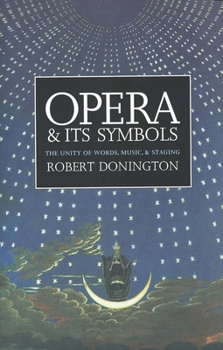Opera and Its Symbols: The Unity of Words, Music and Staging
Select Format
Select Condition 
Book Overview
In this book the late musicologist, performer, and writer Robert Donington discusses the workings of symbolism in opera and the importance of staging an opera in keeping with the composer's intentions. His analysis includes scenes and characters from operas by Monteverdi, Mozart, Verdi, Wagner, Bizet, Puccini, Debussy, Strauss, Stravinsky, Berg, Britten, Tippett, and other composers
Format:Paperback
Language:English
ISBN:0300056613
ISBN13:9780300056617
Release Date:September 1992
Publisher:Yale University Press
Length:260 Pages
Weight:0.85 lbs.
Dimensions:0.7" x 6.0" x 9.2"
Customer Reviews
3 ratings
A glorious tour de force!
Published by Thriftbooks.com User , 19 years ago
The musicologist, thinker, performer and writer Robert Donington deciphers the hidden codes and discusses the different facets in opera according the composer's intentions . He makes an impressive journey . To my mind the golden chapters turn around The Masonic Vision , Verdi and specially descriptive and gratifying results Wagner's analysis. It begins obviously with the Flying Dutchman , Wagner's ring and the late Wagner. His fascinating and penetrating research lead us to the most intimate fibers of the mind , soul and heart of every character . In the Chapter 15 :The destructive seductiveness of Carmen he brilliantly goes to the fundamental backgrounds in Literature and makes a smart web of annotations for his final statement when he affirms : Bizet could not exorcize his demons That's is very interesting because in art you have to live with your inner demons , knowing so well or even better that themselves to make your own journey , because otherwise your scope will be always shaded and limited . Only those artists who could make that difficult but indispensable agreement are universal and timeless. From Monteverdi, Mozart , Verdi, Wagner, Bizet, Puccini, Debussy, Strauss, Stravinsky, Berg , Britten, Tippet and other composers. Acquire this text . It will be too hard to find another approach so challenging and defiant like this one.
The three-fold challenge of opera
Published by Thriftbooks.com User , 20 years ago
If an operatic producer unravels a single thread of the original composer's unity of words, music, and staging (almost always it is the staging that is tugged and twisted), then the opera's symbolic center will not hold.Opera demands commitment from audiences who wish to enter its world of symbols and metaphor. According to the late musicologist, performer, and writer Robert Donington, the complex structure of opera also demands a commitment from its producers to honor the composer's original intentions. As an example of a performance where the composer's intentions were not honored, and the staging did not support the words and music, this author cites Patrice Chéreau's Marxist vision of "Siegfried" at Bayreuth in 1976: "a controversial production that substituted an irrelevant modernist symbolism for Wagner's explicitly prescribed archetypal imagery.""Opera and its Symbols" is by no means a thorough, century-by-century survey of operatic archetypes. Donington singles out certain operas such as Monteverdi's "Orfeo," Verdi's "Rigoletto," and Tippett's "The Midsummer Marriage," while other composers such as Rossini must make do with a single paragraph. An earlier book by this author, "The Rise of Opera," allows him to recall "in the briefest possible way" the beginning of Western opera in the late Renaissance, when interest in Neoplatonic symbolism and the poets of antiquity was at its height. In this atmosphere, it was logical for opera to originate with deliberate as opposed to spontaneous symbolism, and various allegorical creations such as Virtue and Love in Monteverdi's "L'incoronazione di Poppea" are given life, costume, and song.The absurdly melodramatic operatic extravaganzas of the Age of Reason are viewed as a broadening out into the archetypes of human relationships. Donington is especially fascinated by the Oedipal scenario. After all, he himself is a citizen of the 20th century and must view opera--even the 'exotic and irrational' works of Lully and other Baroque composers--through the symbolism of Freud and Jung. I personally feel the author overdoes the mother/incest imagery just a bit--really, my only complaint about this wise and interesting book. A brief look at the index reveals references to "Bizet's mother problem (pp.146-47)," "Britten's mother problem (p.179)," "Tchaikovsky's mother problem (pp. 148-49)," and "Puccini's mother problem (p. 151)." Then there is the transmuted mother-longing in Wagner's operas, and the barely suppressed incest theme of "Rigoletto."Donnington lingers fruitfully through four chapters on Richard Wagner and his haunting archetypes of redemption. Of course, this composer was "unusually aware of his own symbolical intentions."The final chapters deal with 20th century composers, especially the British Tippett and Britten. The author has some startling insight on Stravinsky and the insecurity of an age that is haunted by the possibility of its own obliteration. He is a bit more brusque with
A new perspective on familiar operas
Published by Thriftbooks.com User , 23 years ago
I have enjoyed this book very much. It offers a very interesting psychological perspective on opera whose stories one may just take for granted. The analyses include selected operas from Monteverdi up to the twentieth century composers. Particular emphasis is placed upon Wagner's work, and most of all on "Der Ring des Nibelungen", with the list of the most important leitmotives and the concepts they allegedly represent added in an Appendix to the book. So, if you think you may be interested in a short analysis of "Lohengrin" from Elsa's perspective, or Don Giovanni as suffering from Oedipus complex, this book may be for you. You may not agree with everything, but it will definitely give you new insights on some of the familiar works.




